Lillian Ruth LeVesconte was born on January 29th, 1901, in Prior Lake Minnesota, to John and Lillie Belle LeVesconte who already had a son and daughter – Harold and Amy – and would later add a second son, Lester, to their family. At 23 years of age, Lillian completed her Bachelor of Arts at Macalester College in St. Paul, Minnesota, where she met her future husband, James (Jim) Ira Dickson. Shortly after, she attended the Biblical Seminary in New York City. Little did she know that someday she would declare to her husband and repeat in her letters from Taiwan: “‘Nothing I studied in college is of any use here,’ […] ‘All the things I should know I learn by painful mistakes! Who would have ever guessed our life would be like this?’” (1997-5006-2-1; circular letter dated May 15, 1959)
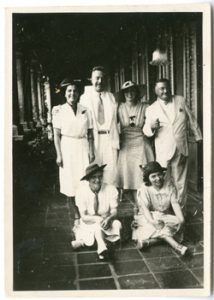
On May 16th, 1927, Lillian Ruth LeVesconte and the Rev. James Ira Dickson were married and began to plan for their trip abroad to serve as missionaries in Formosa (now known, and hereafter referred to, as Taiwan) under the Board of Foreign Missions of The Presbyterian Church in Canada. Rev. Dickson was to serve at the Taiwan Theological College while Lillian served as a missionary’s wife. Letters from Lillian to her family and friends back in the Unites States show that life as a missionary’s wife could be both busy and lonely, and that living in Taiwan was quite the adjustment to make, especially without Western media: “We so enjoy the magazines and papers,-I especially like the magazines. It helps to pass the evenings that I am alone, besides keeping me a wee bit in touch with the world.” (1997-5006-3-2; letter dated June 8, 1930)
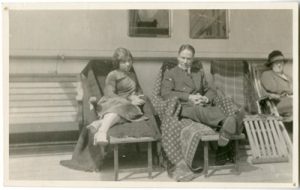
Jim was very busy with his work while Lillian struggled to learn the language part time, cared for the house, attended to her own activities with other missionaries, and supported Jim’s roles – such as the typing meeting minutes and the grading of some papers. Learning languages was particularly challenging for Lillian and she described it thus:
When we first reached the shores of Formosa, and I found myself faced with the Chinese language, I had much of the ‘lost’ feeling [… T]he Chinese language always seemed to me like a wall that I had to scale before I could accomplish anything. The other missionaries spoke of ‘The Language’ in a tone that made one feel that it was something to be regarded with respect and awe, which one did or didn’t ‘get’, quite apart from worthiness of character of even earnestness of desire. ‘Some people just could never ‘get’ the language’, they said,-anyhow, it left one with a sort of desperate fatalism as one buckled down to language study. I studied principally because I wanted to get over the ‘wall’,-I wanted to sit down on the other side and rest with no wall in front of me, […]
(1997-5006-1-2; letter dated October 28, 1935)
Between 1928 and 1932, Lillian also endured four pregnancies – the first baby died shortly after a premature birth and the second was stillborn. Lillian would later sometimes mention her loss of two babies in her circular letters to North America while commenting on the tragedies of Taiwanese women and families.
On November 29th, 1930, Lillian gave birth to Ronald – a healthy baby boy. Almost two years later, on July 13th, 1932, Marilyn was born, also healthy. The family would bring several pets into their family over the years – usually dogs, as they helped Lillian feel safer at night when Jim was away working while she and the children were alone at home.
Time moved on and the Dicksons adjusted to life in Taiwan as well as the affects of the Depression in North America. During this early period in Taiwan they received a visit from Lillian’s sister, Amy, and the Dickson family received and sent off many parcels of goods to Lillian’s family in the United States.
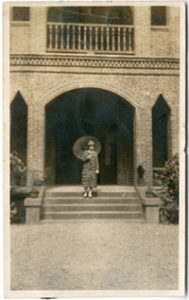
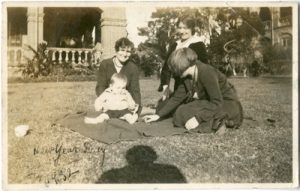
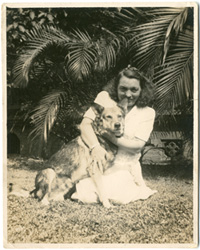
The late 1920s and early 1930s were also a challenging time for the PCC, as the United Church of Canada formed in 1925, and some missionaries were identifying one way or another. Lillian comments on the tense period in 1933, as the General Assembly of the PCC had met in early June:
We are all waiting anxiously for the outcome of it,-it seems so long to have to wait a month after the affair is over, before knowing what has happened. Then we will know about […] whether those among us that are Unionists will be dismissed. It seems to queer to us out here to have people at home making such a fuss as to what ‘fold’ you are in, Unionist or Presbyterian, because here we never think of denominations, the great question here is whether people are Christian or not.
(1997-5006-3-3; letter dated June 18, 1933)
From August of 1933, the Dicksons tended to spend several summer months in a mountain cottage of Japan, where the weather was much more tolerable for the family, with other missionary families nearby.
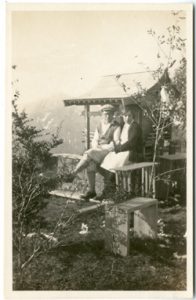
Their furlough was delayed somewhat until late June, 1934. It was the children’s first visit to North America, and specifically Toronto:
Thanksgiving night as Jim was away, I decided that a big feast would be useless for the children and decided to give them an outing instead. The day was clear and warm and we took a ferry across Lake Ont. to Center Island in Lake Ontario,-the children played in the sand on the shores and on the grass,-it is mostly a park,-we had dinner in a hotel there.
(1997-5006-3-3; letter dated “Sunday afternoon Oct. 1934”)

In 1935, the family returned to Tokyo, then Karuizawa in the mountains near Mt. Asama in Japan, where the Dicksons would study Japanese for a year prior to their return to Taiwan.
By the fall of 1936 the family was back to their usual work in Taiwan, and continued serving until late October of 1940, when the war forced them into leaving for America. They travelled to Pearl Harbor where they stopped briefly, then San Francisco by late November. By 1941, the Dicksons were reassigned to New Amsterdam, Guyana (now British Guiana) in South America, at Berbice High School.
Life in British Guiana was difficult during war time for the Dicksons with limited quantities and variety of edible goods and other items. Lillian’s personal letters indicate that while Ronald fared quite well, Marilyn longed to return to the United States, particularly to live with her Aunt Amy. Eventually it was decided that Marilyn would return to the U.S., chaperoned by another missionary couple, eventually to live with Amy and attend school. Shortly after, it was arranged that Ronald was also to return to the U.S. in order to attend a regular school setting.
After World War Two ended, Lillian and Jim finally returned to Taiwan where Jim served as Principal of the Taiwan Theological College. Over the next few years, Lillian began working to help serve and build support for those without the infrastructure in Taiwan to care for themselves, their family, or their children. Her work would eventually culminate into the non-profit agency, The Mustard Seed, which was registered in California in 1954.
The political atmosphere in Taiwan at the end of the 1940s and onwards was almost always precarious, or at the least, uncertain; threats of communism from mainland China, non-recognisance of Taiwan as an independent political state, and the usual and unusual natural and social issues were constantly made apparent in Lillian’s daily life:
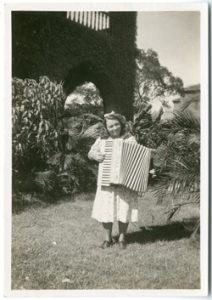
I have no way of knowing how much news you hear at home of political conditions over here. We are living in an atmosphere of intense tension, grim with portent. Every day brings new rumours, fresh alarms. It is only because we are under God’s care and have our eyes and hearts set on one goal, that of bringing the good news of the Gospel to as many as possible while there is time, that we are able to proceed with comparative tranquility. Refugees and evacuees are storming our shores by plane and boat by more than tens of thousands. My guests used to come by ones and twos, now and then a group, but now,- last night we had a letter asking if we could give shelter to an orphanage and a whole theological college student body.
(1997-5006-1-2; circular letter dated December 10, 1948)
Over the following decades, Lillian continued to focus on the projects of The Mustard Seed, while keeping in mind that a change in the political situation could force her and all of the other Christian projects out of Taiwan – should Taiwan come under Communist control. Nonetheless, Lillian continued her work – often known best for playing songs on her accordion and singing along. Lillian’s reflections on her work were usually quite frank, while she retold a wide variety of interesting stories in her circular letters:
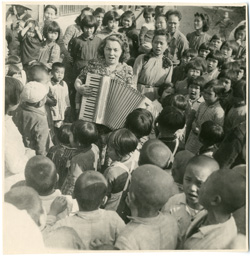
There is one place in the mountains where I always meet drama of such unbelievable texture as to make one believe that it is only melodrama that one is playing a part on stage. Each time I enter there into the mountains I think to myself, ‘This time it will be different. This time it will be calm and usual as the other places are,’ and yet, before I leave I run into events that leave me feeling that I am coming out knee-deep in intrigue and dragging cobwebs of mystery around me.
(1997-5006-1-2; circular letter dated January 26, 1952)
The adventures and ambitions kept her incredibly busy over the years, often wondering “What is one to do when you have only one body?” (1997-5006-2-1; circular letter dated April 9, 1953) Yet, once The Mustard Seed was in full swing, Lillian would return to the U.S. each fall for speaking tours that soon expanded to include Canada. About to embark on their furlough in 1953, Lillian expressed some anxiety at that point on returning to North America after beginning to feel at home in Taiwan:
If you had lived out at the edge of the world for years on end working among lepers, aborigines, and street children, how would you feel as you faced America once more, and the life there? Would you not feel out of step? It is partly that feeling and partly an overwhelmingly and engulfing joy to be with one’s own kind once more. Our first term in Formosa was lonely. There were only a few foreigners (white people), there were less than a dozen cars on the Island, […]. Then I would grow wildly homesick for the sight of a white face, When I reached Honolulu after that first long term of seven years, I saw at last white faces, American men, in overalls, unloading the ship, and they were talking English. I lingered near without seeming to just to hear their voices talking English. After hearing Chinese for so long, English seemed like music. I understood every word, no straining to get the full meaning as I had to in Chinese. I felt that I wanted to shake hands with them and say ‘I’m back! I’m back!’ But, of course, they didn’t know I was just back, they didn’t know I had even been away, and if they had known, still they would not have been able to understand this tumult of emotion.
(1997-5006-2-1; circular letter dated August 20, 1953)
The Mustard Seed grew quickly, and Lillian had the opportunity to travel to Arabia to meet people interested in the agency. In her letters to Jim, she comments that “Arabia is fascinating. The people look as if they had walked right out of the Bible,–2,000 years seemed wiped out and we feel back in the days of the Bible.” (1997-5006-3-3; letter to Jim dated “1966 – from Arabia”)
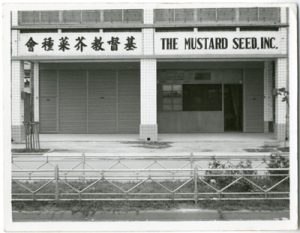
Even though Lillian still had many years left to her life, she began to notice her changing role in The Mustard Seed as new people became involved in the organization. She recalls a conversation with Kenneth L. Wilson of the Christian Herald Magazine during his research visit for Angel At Her Shoulder:
We were marooned on an island in the Pescadores in the town of Makung, halfway to the mainland of China. The ‘wild wind’ precluded leaving by plane or boat, and the Cuban crisis was popping over on the other side of the world.
‘I have two fears,’ he told me whimsically. ‘One is that the office in New York can’t get along without me, and the other is that they will find out that they can!’
Wistfully just now I think the same.
(1997-5006-2-2; circular letter dated May 30, 1966)
Only a year later Jim would pass away, just two years after his retirement in 1965. Lillian recalls in one of her circular letters that “It used to be that when my husband had too much to do, he would turn to me and say, ‘You’ll have to go in my place!’ and I said that ‘All my wildest and out-of-this-world adventures were prefaced by that sentence.’” (1997-5006-2-2; circular letter dated October 30, 1967)
As Lillian continued her circular letters into the 1970s, she continued to include information on the work of The Mustard Seed, but also often mused about life, how she felt about human behaviour, and what the world would be like in the future:
We are always pinning medals on each other and presenting plaques and having pictures taken for the newspaper, or trying to surpass one another in polite ways. ‘How many times have you been around the world? How many books have you written? How many degrees have you secured? How much money have you? What kind of home or car?’ It sounds like children saying, ‘I have five marbles,-how many have you?’ A few hundred years from now surely people will be different,-wouldn’t it be interesting if we could stay around and see?
(1997-5006-2-3; circular letter dated April 30, 1970)
Lillian would also comment on her childhood and draw analogies to the fast-paced world and workings of The Mustard Seed:
Have you ever tried to run and jump onto something that was already moving such as a train or a car? I remember as a small girl coming home from school in Minnesota we would often try to run and jump on a horse-drawn bob-sled and stand on the runner and get a free ride for part of the way home. But once when I did that, I looked down into the sled and there staring at me with wide glaring eyes and mouth open showing big white strong teeth, was a large wolf. It was dead of course and they bringing [sic] it into town, but it frightened me so I never dared jump on a bob-sled again!
(1997-5006-2-5; circular letter dated June 30, 1977)
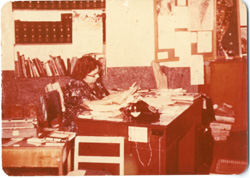
Even in her final years, still busy at work, Lillian had a sense of humour in the everyday of life. In one letter to Marilyn and the grandchildren she added a post script comment for the grandchildren:
P.S. Tell the twins. The other night I found a CENTIPEDE walking across my kitchen floor. As I have screen doors everywhere, I can only guess that when the typhoon blew the window glass in and left large holes for anything to enter, that it also blew in the CENTIPEDE. I banged his head, so I think his last 75 legs were still wiggling.
(1997-5006-3-3; letter to Marilyn dated August 15, 1977)
After receiving eye surgery in the U.S. and returning to Taiwan, she signed off a letter to Marilyn and family: “Love to you all,-I still have the patch over my eye, Long John Silver, female edition.” (1997-5006-3-3; letter to Marilyn dated December 3, 1980) In another letter to Marilyn and family, Lillian tells a short story about a guest she received: “Someone called on me the other day and after saying all the polite meaningless things expected such as ‘But you don’t look eighty, etc.’ then he leaned across the desk and spoke to me confidentially, ‘Are your teeth real?’ It was a little like ‘Are you over a hundred?’” (1997-5006-3-3; letter to Marilyn dated January 20, 1981) Slowly, Marilyn began to take over the circular letters to North America, and Lillian passed away on January 14th, 1983, in Taiwan at the age of 82.
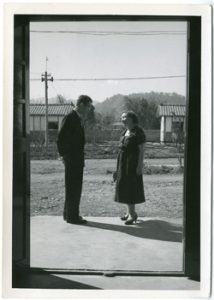
This Project has been made possible [in part] by the Government of Canada through the Young Canada Works and Heritage Organizations Program. « Ce projet a été rendu possible [en partie] grâce au gouvernement du Canada par de Jeunesse Canada au travail et le Programme des organismes patrimoniaux». This exhibit was created by the Archives summer intern, Victoria Baranow.
*Copyright 2012 – The Presbyterian Church in Canada
If you wish to quote or use any part of this website exhibit, please give credit to The Presbyterian Church in Canada Archives.